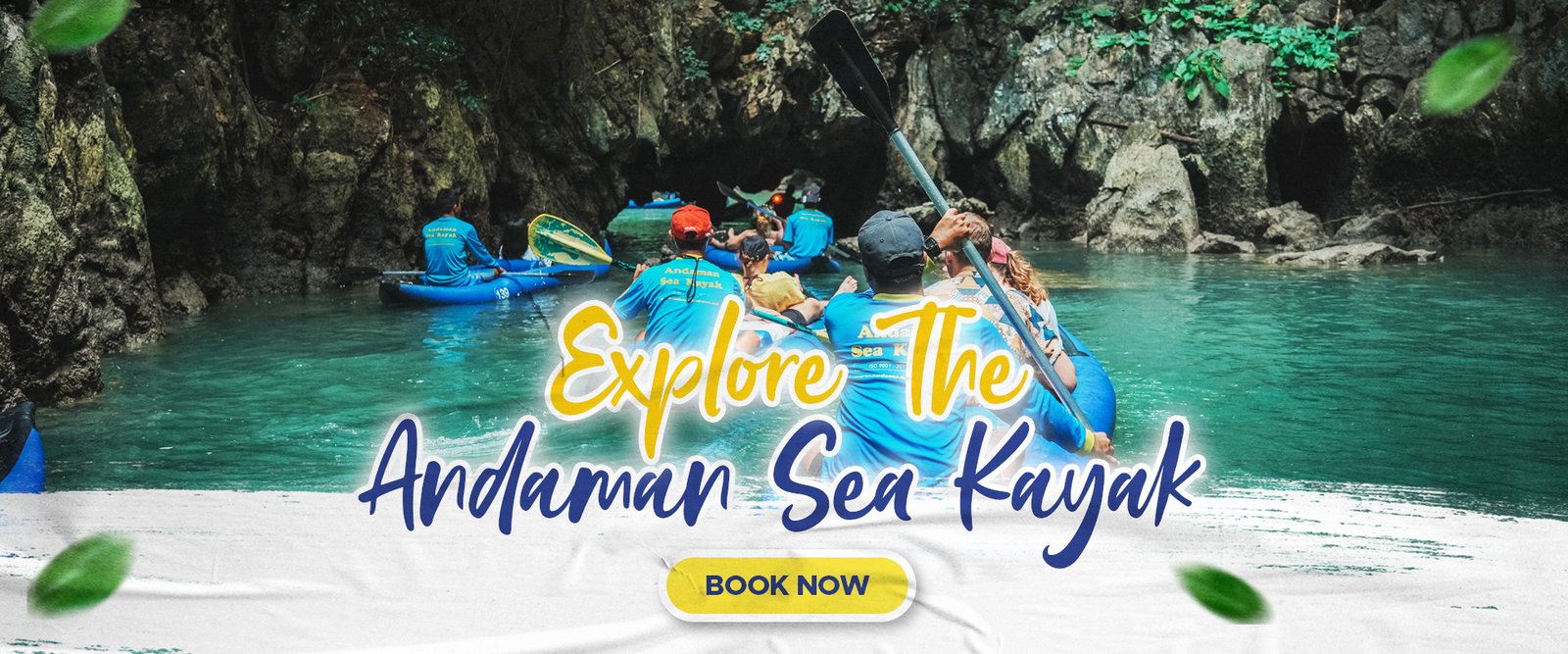Beginner’s Guide to Kayaking Tips for First-Timers

Imagine gliding silently through crystal-clear turquoise waters, exploring hidden caves and secret lagoons that can’t be reached any other way. The gentle splash of your paddle, the call of exotic birds, and the breathtaking limestone formations towering above you. This is the magic of kayaking in paradise destinations like Phang Nga Bay, Thailand—an experience that combines adventure, tranquility, and connection with nature in perfect harmony.
Kayaking is a versatile water sport that appeals to adventure seekers of all ages and fitness levels. Whether you’re considering a peaceful paddle on a calm lake or an exciting exploration of coastal caves, this comprehensive guide will prepare you for your first kayaking adventure with essential tips, safety guidelines, and practical advice for an unforgettable experience.
Understanding Kayaking Basics
Kayaking originated thousands of years ago with the Inuit and Aleut tribes who used these narrow watercraft for hunting and transportation in Arctic regions. Today, it has evolved into both a recreational activity and competitive sport enjoyed worldwide.
Types of Kayaks for Beginners
Before diving into techniques, it’s important to understand the different types of kayaks available:
- Sit-on-top Kayaks: Perfect for beginners, these stable, self-draining kayaks are ideal for warm environments. They’re easier to get in and out of, making them excellent for first-timers.
- Recreational Kayaks: Designed for calm waters like lakes and slow-moving rivers. These are wider, more stable, and often more affordable than specialized kayaks.
- Sea/Touring Kayaks: Longer and narrower with storage compartments, these are built for open waters and longer journeys. Best for more experienced kayakers, but some guided tours use stable versions for beginners.
- Inflatable Kayaks: Portable and easy to store, modern inflatable kayaks offer surprising stability and durability for casual paddling.
For your first kayaking experience, particularly in tropical destinations like Phang Nga Bay, you’ll likely use a stable sit-on-top or recreational kayak that provides excellent balance and ease of use.
Essential Gear for Beginners
Proper equipment ensures both safety and enjoyment during your kayaking adventure. Here’s what you need:
Must-Have Kayaking Equipment
- Personal Flotation Device (PFD): The most essential piece of safety equipment—always wear a properly fitted life jacket regardless of your swimming ability.
- Paddle: The standard kayak paddle has blades on both ends. For beginners, choose a paddle sized according to your height and the width of your kayak.
- Appropriate Clothing: Dress for water immersion, not air temperature. In tropical locations, quick-dry clothing, UV protective shirts, and swimwear are ideal. In cooler climates, consider synthetic layers or wetsuits.
- Sun Protection: Hat, sunglasses with retention strap, and waterproof sunscreen are crucial, especially when kayaking in sunny destinations like Thailand.
- Hydration: Bring ample water in a secure bottle to prevent dehydration.
When joining guided tours like those offered in Phang Nga Bay, most essential equipment will be provided, including life jackets, paddles, and often dry bags for your belongings.
Preparing for Your First Kayaking Trip
Proper preparation enhances safety and enjoyment during your kayaking adventure.
Physical Preparation
While kayaking is accessible to most fitness levels, some basic preparation helps:
- Simple shoulder and core stretches before paddling prevent strain
- Light cardio training improves endurance for longer trips
- Upper body strengthening exercises can enhance your paddling power
Mental Preparation
- Research your destination and expected conditions
- Understand basic water safety principles
- Set realistic expectations for your first experience
- Be prepared to get wet and embrace the adventure
Practical Preparations
- Check weather forecasts for your planned kayaking day
- Inform someone of your plans if going independently
- Arrive rested and well-hydrated
- Eat a light meal before setting out
Fundamental Kayaking Techniques
Mastering basic techniques enhances your kayaking experience and builds confidence on the water.
Getting In and Out of Your Kayak
- Beach Entry: Position the kayak perpendicular to the shoreline in shallow water. Straddle the kayak, lower yourself onto the seat, and then bring your legs in.
- Dock Entry: Sit on the dock with the kayak alongside. Place your paddle across the kayak behind the seat for stability, then lower yourself into the seat while holding the dock and paddle.
Basic Paddling Techniques
- Forward Stroke: The fundamental kayaking motion. Insert the blade fully into the water near your feet, then pull alongside the boat until it reaches your hip. Rotate your torso rather than just using arm strength.
- Reverse Stroke: To move backward, perform the forward stroke in reverse—start the stroke at your hip and push the water forward.
- Sweep Stroke: For turning, extend your arm forward and make a wide, sweeping arc with the paddle from the front of the kayak to the back.
- Draw Stroke: To move sideways, place the paddle blade at a right angle to the kayak, then pull the water toward you.
Body Positioning
- Sit upright with your back straight against the backrest
- Keep your feet comfortably positioned on the footrests
- Engage your core for stability and efficient paddling
- Relax your grip on the paddle to prevent fatigue and blisters
Safety Guidelines and Best Practices
Safety should always be your priority when kayaking, especially as a beginner.
Basic Safety Rules
- Always wear a PFD: Even strong swimmers need life jackets in emergencies.
- Check conditions before launching: Wind, current, and weather can dramatically impact kayaking difficulty.
- Stay within your skill level: Choose calm, protected waters for your first outings.
- Practice wet exits: Learn how to safely exit your kayak if it capsizes.
- Follow the “Rule of Three”: Ideally, kayak with at least three people so one can stay with a person in trouble while another gets help.
What to Do in an Emergency
- If you capsize, stay with your kayak—it floats and provides visibility
- In currents or waves, position yourself on the upstream side of the kayak
- Signal for help using a whistle or paddle raised vertically
- Practice deep breathing to remain calm during unexpected situations
When participating in guided tours like those in Phang Nga Bay, professional guides are trained in rescue techniques and first aid, providing an additional safety net for beginners.
Choosing the Perfect Location for Beginners
The right environment makes a tremendous difference in your first kayaking experience.
Ideal Conditions for Beginners
- Protected waters with minimal current
- Areas without heavy boat traffic
- Easily accessible launch points
- Wind-sheltered locations
- Clear water for better visibility
Why Places Like Phang Nga Bay Are Perfect for Beginners
Destinations like Phang Nga Bay offer ideal conditions for first-time kayakers:
- Calm, sheltered waters protected by limestone formations
- Professional guides who prioritize safety
- Stable, easy-to-use kayaks designed for beginners
- Breathtaking scenery that rewards even slow, cautious paddling
- Crystal-clear waters with amazing visibility for added confidence
Other Global Destinations Ideal for Beginner Kayakers
- Monterey Bay, California: Protected waters with abundant wildlife
- Lake Louise, Canada: Calm glacial waters with stunning mountain scenery
- Abel Tasman National Park, New Zealand: Sheltered bays with golden beaches
- Loch Lomond, Scotland: Tranquil waters surrounded by picturesque landscapes
Environmental Responsibilities While Kayaking
Kayaking allows unique access to fragile ecosystems, bringing important environmental responsibilities.
Leave No Trace Principles for Kayakers
- Pack out all trash, including biodegradable items
- Avoid disturbing wildlife by keeping a respectful distance
- Stay on designated trails when launching or landing
- Respect private property and restricted areas
- Leave natural objects and cultural artifacts as you find them
Protecting Marine Ecosystems
- Avoid dragging your kayak over sensitive reef systems
- Don’t touch or collect marine creatures or corals
- Use reef-safe sunscreen to protect marine life
- Consider joining conservation-focused kayak tours that educate about ecosystem protection
Leading kayaking operators, like those at Phang Nga Bay, often incorporate environmental education into their tours, helping visitors understand the importance of preserving these natural wonders for future generations.
Why Guided Tours Are Perfect for First-Timers
For beginners, guided kayaking tours offer significant advantages over independent paddling.
Benefits of Professional Kayaking Tours
- Safety: Professional guides trained in rescue techniques and first aid
- Equipment: Quality, well-maintained kayaks and appropriate safety gear
- Instruction: On-the-spot technique guidance and paddling tips
- Knowledge: Informed commentary about local ecology, geology, and history
- Route Planning: Expertly chosen routes suitable for beginners that maximize scenic views while avoiding challenging conditions
- Convenience: Transportation, equipment, and sometimes meals arranged for you
What to Expect on a Guided Tour
When joining a professional tour, like those exploring the hidden caves of Phang Nga Bay, expect:
- A thorough safety briefing before launching
- Basic instruction on paddling techniques
- Information about the day’s route and highlights
- Guidance through challenging spots
- Fascinating information about the local environment
- Often a meal or refreshments included
How to Choose the Right Tour Operator
Look for operators who:
- Emphasize safety with appropriate guide-to-participant ratios
- Use quality, well-maintained equipment
- Have positive reviews mentioning knowledgeable guides
- Demonstrate environmental responsibility
- Provide clear information about what’s included
- Have appropriate certifications and licenses
Physical and Mental Benefits of Kayaking
Beyond the adventure, kayaking offers numerous health benefits that make it worth adding to your regular recreation options.
Physical Benefits
- Full-Body Workout: Paddling engages arms, shoulders, back, and core muscles
- Low-Impact Exercise: Gentle on joints compared to many other activities
- Improved Cardiovascular Health: Sustained paddling elevates heart rate for cardiovascular benefits
- Enhanced Strength and Flexibility: Regular paddling builds muscle strength and improves range of motion
Mental and Emotional Benefits
- Stress Reduction: The rhythmic motion of paddling combined with nature exposure significantly reduces stress
- Improved Mindfulness: The focus required for paddling promotes presence and attention
- Nature Connection: Direct contact with natural environments improves mood and mental well-being
- Achievement Satisfaction: Meeting the challenges of learning a new skill boosts confidence
Research indicates that water-based activities in natural settings have particularly strong positive effects on mental health, making kayaking an excellent choice for both physical and psychological well-being.
FAQs for Kayaking Beginners
Q: Do I need to know how to swim to go kayaking?
A: While basic swimming skills are recommended, properly wearing a quality personal flotation device (PFD) allows non-swimmers to kayak safely, especially in guided tour settings with professional supervision.
Q: How physically demanding is kayaking for beginners?
A: Entry-level kayaking, especially on calm waters, is accessible to most fitness levels. Tours can be adjusted for different abilities, and proper technique minimizes strain. Communicate any concerns with your guide.
Q: What should I wear for kayaking in tropical destinations?
A: Quick-dry clothing, swimwear, UV-protective shirts, water shoes, hat, and sunglasses with a retention strap. Avoid cotton, which stays wet and heavy.
Q: Will I get wet while kayaking?
A: Yes, expect at least some splashing from paddles. In sit-on-top kayaks, your lower body will likely get wet. Appropriate clothing makes this part of the enjoyable experience.
Q: How far in advance should I book a kayaking tour?
A: During peak tourist seasons, booking 1-2 weeks ahead is recommended for popular destinations like Phang Nga Bay. In off-peak times, 2-3 days notice is usually sufficient.
Q: What if the weather turns bad during a kayaking tour?
A: Professional tour operators monitor weather conditions closely and will reschedule or adjust routes for safety. Trust your guide’s judgment about weather-related decisions.
Q: Can children go kayaking?
A: Many operators welcome children, typically ages 5 and up, often in tandem kayaks with adults. Child-sized PFDs are essential. Check with specific tour companies for their age policies.
Conclusion: Embracing the Kayaking Adventure
Kayaking offers a unique blend of adventure, tranquility, and natural connection that few other activities can match. As a beginner, starting with guided experiences in ideal locations provides the perfect introduction to this rewarding activity.
The hidden caves and emerald waters of destinations like Phang Nga Bay create unforgettable first kayaking experiences, where professional guides ensure safety while you focus on the wonder of exploration. The feeling of gliding through serene waters, accessing remote areas inaccessible by any other means, creates memories that last a lifetime.
Whether you’re seeking adventure, relaxation, or a deeper connection with nature, kayaking delivers all three in abundance. By following the tips in this guide and starting with professional support, you’re setting yourself up for a fantastic introduction to a sport that many turn into a lifelong passion.
So secure your life jacket, grab your paddle, and prepare to discover the world from a new perspective—just a few inches above the water, moving silently through some of Earth’s most spectacular landscapes.
This guide was created by Andaman Sea Kayak, offering eco-friendly kayaking adventures in Thailand’s stunning Phang Nga Bay since 2015. Our expert local guides are passionate about sharing the natural wonders of our homeland while preserving its fragile ecosystems for future generations. Join us to explore hidden caves and secret lagoons on your next visit to Thailand.







